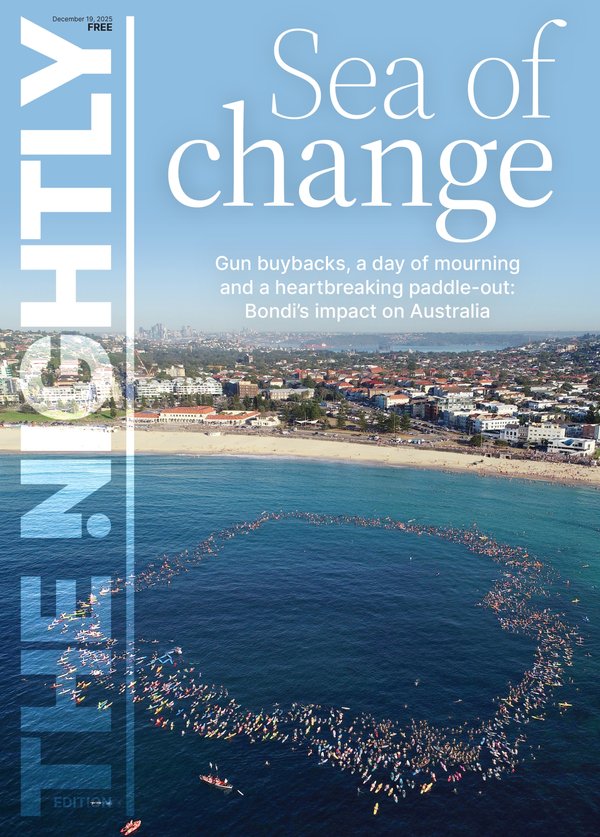Australia’s $100b wipe off: Heavy sell-off eases slightly but Trump tariff carnage continues in Asian markets

Nearly $100 billion has been wiped off the value of Australian equities, in another day of market carnage, sparked by Donald Trump’s tariff policies. Steep losses in morning trade eased on news China might engage in a stimulus program but the bloodbath is continuing in Asia.
Asian markets have had their worst single day since the Global Financial Crisis, with the Hong Kong based Hang Seng index down more than 11 per cent, Japan’s Nikkei down more than 6 per cent and Taiwan’s TAIEX down more than 9 per cent.
European markets are also crumbling on the open, with Germany’s DAXX down 10 per cent, and the Stoxx Europe index down 5 per cent. German arms manufacturer Rheinmetall, fell 27 per cent in opening trade.
Sign up to The Nightly's newsletters.
Get the first look at the digital newspaper, curated daily stories and breaking headlines delivered to your inbox.
By continuing you agree to our Terms and Privacy Policy.Treasurer Jim Chalmers called an unscheduled press conference to address the turmoil, and released Treasury modelling that suggested the impact on Australia from the US tariffs to be “modest.”
“What we’re seeing here is the impact of a series of bad decisions taken about tariffs and the whole world is trying to get their head around the impacts on their own economies and the global economy as well,” Dr Chalmers said.
“We are seeing a very substantial volatility now in global stock markets and in our own markets as well.
“(The RBA) and the government are working out how to ensure that we are best calibrated for this economic uncertainty that we’re all anticipating ahead. Australia is really well placed, and we are well prepared to deal with this global economic uncertainty.”
Speaking on the husting on Monday, Prime Minister Anthony Albanese also addressed concerns.
“We’re seeing a considerable impact, negative impact on the stock market that impacts Australians because superannuation funds have their shares there,” Mr Albanese said.
“I’m concerned about the impact in Asia. If you look at the impact of some of the tariffs in Asia, some of them were quite high.”
The market’s sharp retreat comes after US benchmark the S&P 500 lodged its biggest weekly drop since March 2020 on Friday and the tech-focused Nasdaq composite ended down more than 20 per cent from its December record high — confirming the index is in a bear market. Steadfast commitment by President Trump to his tariff policy, and the application of a 34 per cent reciprocal tariff on the US by China has investors convinced the world is on the precipice of a global trade war

In the opening minutes of trading on the Australian Securities Exchange, shares were down 6 per cent, with some of the country’s biggest names savaged. By the close of trading The S&P/ASX 200 Index was down 4.2 per cent marking the worst one-day loss since May 2020. The index is now down 8 per cent following the tariff announcement.
Chief among those hit were two of Australia’s largest companies, BHP and Commonwealth Bank, which fell more than 9 per cent on the open. Both shares have recovered but still remain down 5 per cent. Across the exchange every sector was in the red with only 12 stocks in the ASX200 managing to eke out a positive return. Two of those companies were subject to takeover bids from overseas.
Steepest falls were in trade related sectors with miners leading the way down, and energy stocks crushed. Oil producer Santos fell 9 per cent, while Woodside was down 4.7 per cent. In the last five days the two stocks are down 19 per cent and 17 per cent respectively. They fell as Saudi Arabia cut the price of crude oil by 4 per cent.
Tariff shock “modest” for Australia
Modelling by Treasury, commissioned by Dr Chalmers on Thursday, forecasts the tariff shock — including China’s retaliation — will lead to a 0.1 per cent decline in Australian GDP and a 0.2 percentage-point increase in inflation in 2025, relative to a scenario with no new tariffs.
Over the medium term, Australia’s GDP is permanently lower, Treasury said, while the inflationary impact is temporary.
The pain felt in the US and China will be significantly higher, with US GDP expected to be 0.8 per cent lower by 2027 and inflation to rise by about 1.4 percentage points initially, driven by the higher cost of imported goods.
China’s GDP is expected to fall by 0.6 per cent, and Treasury forecasts trade-exposed sectors such as agriculture, energy, mining and durable manufacturing will be hit hardest. Some Australian agricultural exports may benefit from displaced US trade, however.
Around 80 per cent of the total impact on Australian GDP is expected to stem from flow-on effects from weaker Chinese consumption, rather than direct losses from diminished exports to the US, which account for less than 5 per cent of total Australian exports.
“We expect, and the Treasury expects, the implications for growth and inflation in the US and elsewhere to be very substantial. This is one of the many reasons that we describe the tariff decision to be ill considered and unwarranted. The damage being done by that tariff decision is now very clear for all to see,” Dr Chalmers said.

While the Treasury modelling was released to the Opposition under the rules of a caretaker government, Opposition Finance spokesman Angus Taylor has written to Treasury Secretary Steven Kennedy requesting a daily briefing while the government is in caretaker mode.
“Noting the ongoing impact of the current market volatility, and its potentially profound implications for Australian families the Coalition believes it is critical that these briefings occur,” Mr Taylor wrote.
Rate cuts expectations
Treasurer Chalmers amplified market expectations for a series of rate cuts by the Reserve Bank in response to the volatility.
Markets are now pricing a rate cut in May with 100 per cent certainty, and expectations are that there will now be four rather than three rate cuts for the year.
“I don’t predict or preempt those decisions, but there’s even a more than even money expectation in the markets, that the next Reserve Bank interest rate cut in May might be as big as 50 basis points,” Dr Chalmers said.
The Australian dollar has continued to suffer from negative sentiment, and excluding COVID has fallen to its lowest level in nearly 25 years.
It is now sitting a hair’s breadth above 60 US cents.
Driving investors away from the dollar are fears of a dampening of Chinese demand for Australian mineral resources, and the expectation of interest rate cuts. A lower yield on government bonds makes the currency less attractive to investors.
All eyes are now turning to what might be the circuit breaker for this selloff.

So far, President Trump has given little indication that he will change his policy, telling reporters “our country has gotten a lot stronger.”
“What’s going to happen, I can’t tell,” Mr Trump said.
Increasingly however, Trump is finding himself friendless among the investor class in America.
Bill Ackman, one of Wall St’s most prominent investors and vocal Trump supporter has turned on the President and his secretary of commerce Howard Lutnick.
Writing on X, Mr Ackman, who controls $15b in assets via his firm Pershing Square, accused Mr Lutnick, the former long time chair of investment bank Cantor Fitzgerald of an “irreconcilable conflict of interest”.
“I just figured out why Howard Lutnick is indifferent to the stock market and the economy crashing,” Mr Ackman wrote.
“He and Cantor are long bonds. He profits when our economy implodes. It is a bad idea to pick a Secretary of Commerce whose firm is levered long fixed income.”
Some pushback from Congressional Republicans is also starting to form, with seven senators backing a bipartisan bill to place limits on Trump’s tariff authority.
American citizens are also increasingly mobilised, with hundreds of thousands rallying across the country to protest Mr Trump’s policies.
If Mr Trump is not coerced into changing policies by the fall in the stockmarket, the next option for policy change would not take place until mid-term Congressional elections in 2026.

